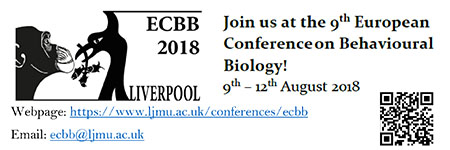Proceedings of the 9th European Conference on Behavioural Biology
A special issue of Animals (ISSN 2076-2615).
Deadline for manuscript submissions: closed (31 March 2019) | Viewed by 21296
Special Issue Editors
Special Issues, Collections and Topics in MDPI journals
Special Issue Information
Dear colleagues,
This Special Issue of Animals is open for submission of papers presented at the 9th European Conference on Behavioural Biology, organized by Liverpool John Moores University at Liverpool, UK, 9–12 August 2018.
The Special issue will cover the latest developments in animal behaviour and biology and related fields, such as ecology, evolution, genetics, physiology, cognition, welfare and conservation.
Prof. Oliver Burman
Dr. Emily Bethell
Guest Editors
Manuscript Submission Information
Manuscripts should be submitted online at www.mdpi.com by registering and logging in to this website. Once you are registered, click here to go to the submission form. Manuscripts can be submitted until the deadline. All submissions that pass pre-check are peer-reviewed. Accepted papers will be published continuously in the journal (as soon as accepted) and will be listed together on the special issue website. Research articles, review articles as well as short communications are invited. For planned papers, a title and short abstract (about 100 words) can be sent to the Editorial Office for announcement on this website.
Submitted manuscripts should not have been published previously, nor be under consideration for publication elsewhere (except conference proceedings papers). All manuscripts are thoroughly refereed through a single-blind peer-review process. A guide for authors and other relevant information for submission of manuscripts is available on the Instructions for Authors page. Animals is an international peer-reviewed open access semimonthly journal published by MDPI.
Please visit the Instructions for Authors page before submitting a manuscript. The Article Processing Charge (APC) for publication in this open access journal is 2400 CHF (Swiss Francs). Submitted papers should be well formatted and use good English. Authors may use MDPI's English editing service prior to publication or during author revisions.







